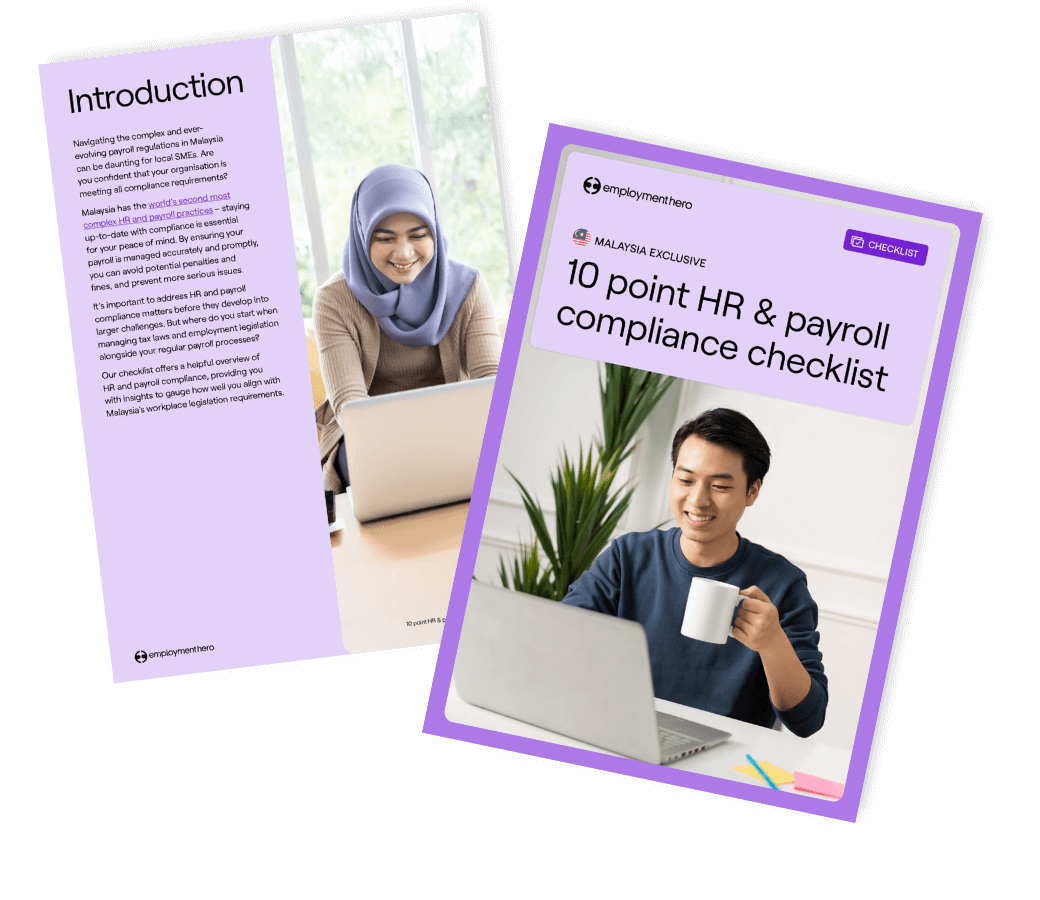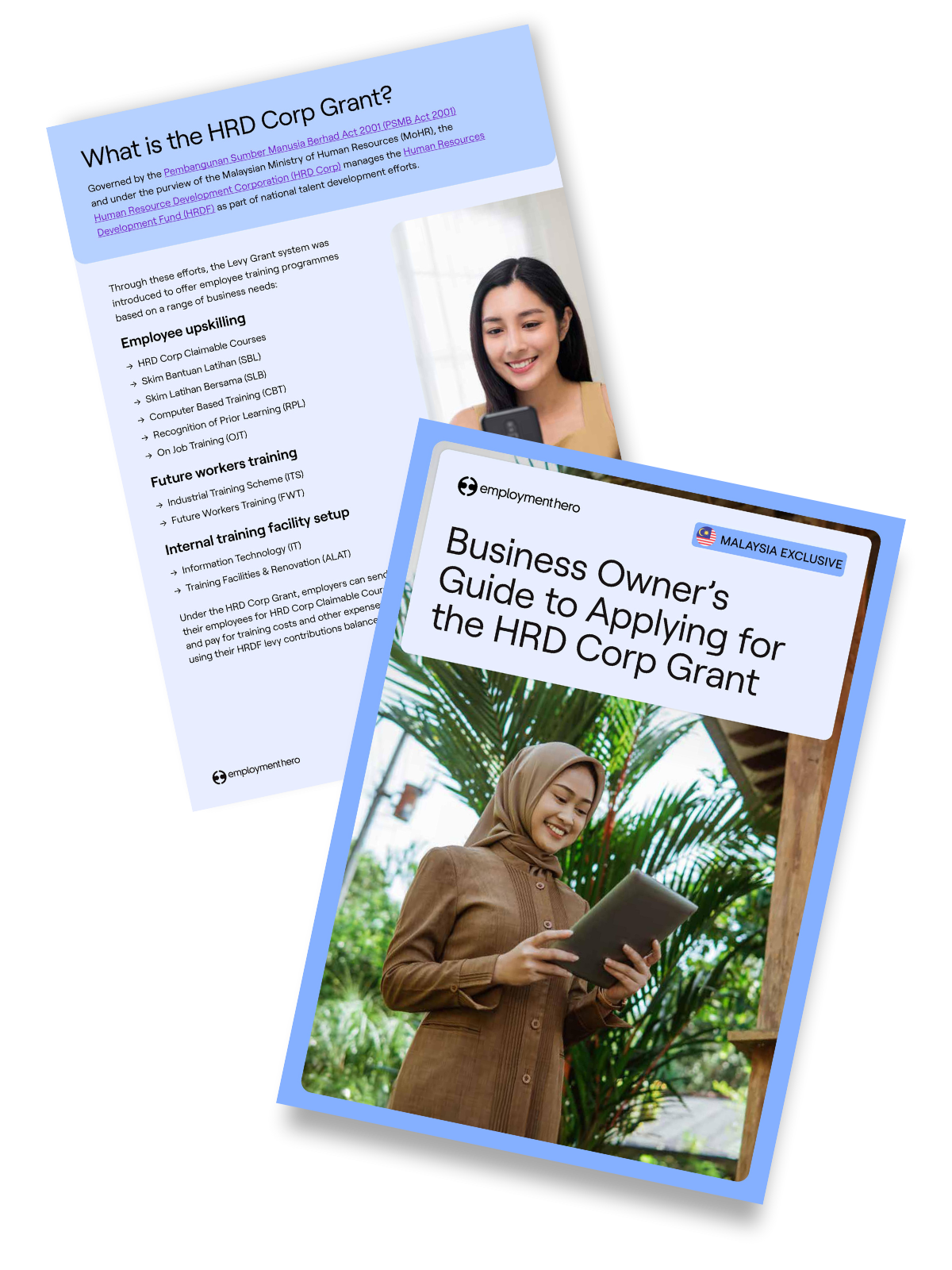8 Top HR Trends for Malaysian Businesses in 2024
Published
8 Top HR Trends for Malaysian Businesses in 2024
2 min read
2023 has been a mammoth year for businesses across the world.
We’ve moved even further into a post-Covid mindset from the past few years, where our concerns instead are dominated by skyrocketing inflation, economic and political instability as well as climate change.
While inflation has gone down recently, it will still have an effect on the rest of 2024 – the same goes for the near annual flooding on the east coast that weighs on our minds every year.
With Budget 2024 having an allocation of RM393.8 billion, the nation’s biggest ever budget yet, and a healthy roster of reforms under the Madani Economic Framework, tackling the cost of living crisis is well underway for the Malaysian government. How these changes will assist Malaysian small to medium-sized businesses is yet to be seen.
How should HR leaders prepare for what 2024 has in store? Download our free guide now to learn about eight key trends that will shape the year for human resources.
This guide will cover;
- Offering financial wellbeing tools
- Focusing on employee engagement
- Adopting smart recruitment tools
- Reducing the duration of the recruitment process
- Implementing corporate sustainability
- Seeking cultural contribution
- Offering ongoing flexibility
- Embracing digital transformation with smart workplace tech
Disclaimer: The information in this article is current as at 25 January 2024, and has been prepared by Employment Hero Pty Ltd (ABN 11 160 047 709) and its related bodies corporate (Employment Hero). The views expressed in this article are general information only, are provided in good faith to assist employers and their employees, and should not be relied on as professional advice. The Information is based on data supplied by third parties. While such data is believed to be accurate, it has not been independently verified and no warranties are given that it is complete, accurate, up to date or fit for the purpose for which it is required. Employment Hero does not accept responsibility for any inaccuracy in such data and is not liable for any loss or damages arising either directly or indirectly as a result of reliance on, use of or inability to use any information provided in this article. You should undertake your own research and to seek professional advice before making any decisions or relying on the information in this article.
Download the free guide now.
Why is it important for HR leaders to be ahead of HR trends?
HR is constantly evolving in line with business and employee needs. Year to year, HR leaders will be presented with a new set of challenges – and they’ll need a new toolkit of trends and research to face them.
We’ve seen a slew of workplace trends and news moments that have made a huge mark on working culture in the past couple of years, from the Great Resignation to quiet quitting and career cushioning. Employees and industries are always evolving; as the world changes, so too does the way we work.
It’s a common mistake for HR leaders to not keep track of trends, but this can keep them from taking the actions they need to stay ahead. When you understand trends you also keep your finger on the pulse of your industry; which means you can stay competitive and build great strategies when it comes to the recruitment and labour market, employee retention, digital HR and employee wellbeing.
What were the biggest challenges HR departments faced in 2023?
2023 was another rollercoaster of a year. Developments from 2022 continued to rock the world, including geopolitical conflicts and the continued advancement of AI across multiple industries. 12 months later, the pandemic is nearly forgotten outside of seasonal spikes in Covid-19 cases and the occasional news of a new variant crossing our news screens.
Here are some of the biggest challenges HR departments faced in 2023.
Increasing seasonal Covid-19 cases
Just when we thought that the worst of Covid was over, multiple variants swept through the world at different points in 2023, ringing alarm bells.
While mass isolation was not back on the table and sweeping lockdowns did not occur like they did in 2020, many employers found themselves making difficult decisions to keep their teams safe.
Career cushioning
After the Great Resignation and quiet quitting came career cushioning, where employees stay on the lookout for new opportunities without neglecting their professional obligations to their current employer.
Career cushioning is especially prevalent among Malaysian millennials and Gen Z workers due to factors such as wage stagnation and higher cost of living. In response, many companies are reducing their overhead costs in favour of investing in people development to boost employee retention.
Our Talent Insights Report notes that only 8% of surveyed respondents are not taking any actions to future-proof their careers, with 48% of employees looking for internal opportunities and lateral moves compared to 35% back in 2021.
This might bode well for Malaysian employees and businesses in the long run, as the Malaysian government and assorted labour associations have been encouraging skills development to ensure that the local talent pool remains competitive.
The question of returning to the office
As the severity of the pandemic began to slow and many countries took on a ‘living with the virus’ mindset, discussions around long term hybrid or remote work took the spotlight.
What would the impacts and benefits be for things like work-life balance, company culture, workforce diversity and career development?
According to the 2023 Global Remote Work Index (GWRI), Malaysia is one of the top 50 havens for remote workers in the world and second only to Singapore in Southeast Asia. One out of every two working Malaysians is willing to quit their current job for a healthier work-life balance, while 96% of Malaysian workers prefer flexible working arrangements and 37% are willing to take a pay cut to work remotely.
The increased demand for on-site employment has led to issues with talent retention – just across the pond, Singaporeans weigh hybrid options as a crucial factor in considering job offers, and Malaysians are likely to follow suit.
All is not lost, however: Malaysian Employers Federation (MEF) vice-president Nik Mustapha Nik Mohamed voiced his support of hybrid work cultures and flexible working arrangements (FWA) at companies suited to these and if they improve productivity.
A surge in the cost of living
The cost of living surge marked the beginning of an economic downturn for many countries. While we ended 2023 in better shape with lower unemployment rates and inflation, the situation is expected to remain difficult and uncertain as the economy has a bumpy landing from the wild ride the world had in the past few years.
Market research and local statistics show that most Malaysians are financially unstable or living from pay cheque to pay cheque, with almost 35% of employees earning less than RM2,000 a month.
Meanwhile, 48% of Employees Provident Fund (EPF/KWSP) contributors have less than RM10,000 in savings after post pandemic withdrawals. Malaysians are finding it difficult to make ends meet, dipping into their savings for day-to-day expenses.
While Malaysia’s inflation rate is affected by global factors, it has subsided to 2.8% in May. The Malaysian government has also put multiple initiatives into place to control the cost of living, including price monitoring and Payung Rahmah, which extends support and assistance to those in need by offering affordable groceries and meals.
What should HR professionals focus on in 2024?
In 2024, emerging challenges for human resources include continued recruitment and talent management difficulties, economic uncertainty and an increased need to digitise – with many more to come!
Our trends speak to a few key areas of focus.
Smart recruitment
Forget ‘work smarter, not harder’ – this year’s motto is ‘recruit smarter, not harder’.
Despite a tricky past few years, the hunt for talent is showing no signs of slowing down in 2024. Several trends including ‘Adopting Smart Recruitment Tools’ and ‘Reducing the Duration of the Recruitment Process’ reflect the ongoing talent struggles that companies are facing.
Our 2024 Malaysian SME Sentiment Report echoes these findings – local companies are struggling with talent retention and higher salary expectations.
While it’s important to work on attracting talent with strategies like a great Employee Value Proposition (EVP), HR professionals shouldn’t overlook improvements in their recruitment process. We’re in an employee’s market, so HR professionals and hiring managers need to think much more about the candidate experience rather than making them jump through hoops to secure a role.
On the employers’ side, implementing artificial intelligence (AI) initiatives can help with the recruitment process due to the ever expanding scope of work – however, approaching HR tech with intention and asking important questions centred around risks and ethics will help further smooth the process.
Financial wellbeing
Many businesses are anxious about the economic outlook, but so are employees.
With the rise in cost of living, employees are feeling the pinch when it comes to fuel, food, power, services and much more. Financial goals are also looking more uncertain as housing and travel prices fluctuate with the stock market.
Our 2022 Wellness at Work Report found that money is a source of stress for most employees. These pressures can greatly impact their experience at work, causing them to lose motivation or seek external income.
Even in the absence of a salary increase or bonus, there are plenty of things that employers can do to lighten the financial load a little for their teams. Our trends take a deeper look at what HR and employers can do to help big and small.
Great culture
No employer wants to find that their employees are relying on ‘quiet quitting’ to get through the workday.
HR can help remedy disengagement at work by focusing on employee experience and creating a great company culture. That’s why one of our trends this year is ‘Focusing on Employee Engagement’ – this might be able to reinvigorate trust and engagement within rocky employer-employee relationships as we adapt to new work norms.
Remember, a great culture is not made by having some makan-makan at the office. Positive company culture creates diversity initiatives, has measures in place to support working parents, engages in active listening to make positive changes and much more.
Just starting your career in HR and looking to learn more about how you can make an impact? Download our free Intro to HR guide now.
5 reasons HR software can help you stay ahead of key HR trends in 2024
If you haven’t already, is 2024 the year that you take HR digital?
HR software can help you address many emerging trends, not to mention removing HR admin and paperwork from your plate. Here are some of the ways that having a human resources information system (HRIS) can help you run your HR department more effectively in 2024.
1. Amazing recruitment and onboarding tools
Employment Hero’s HR platform includes our incredible Applicant Tracking System which can help you recruit quickly and efficiently.
This recruiting software can assist with the entire recruiting process, from screening potential candidates, scheduling interviews, checking references, and managing the end-to-end hiring process – from attracting star talent right through to paperless onboarding.
Our ATS is cloud-based and integrated with our HR platform, seamlessly connecting with onboarding and employment management processes. Through your applicant tracking system, you have full visibility and easy control over each part of recruitment.
An ATS can help cut down the time it takes to recruit, help your job ads be seen in more places, reduce recruitment admin and provide a central source of truth for all those involved in the recruitment process.
2. Employee engagement made easy
2024 should be the year of the positive employee experience. HR software can help you stay connected to your team, engage with reward and recognition and show overall support for employee well being.
Engage your employees with our easy-to-use tools, and show your team that they are valued everyday.
Our employee engagement suite includes;
- 1:1s (one-on-ones), easily creating regularly scheduled meetings with templated agendas, and places to leave a confidential feedback and discussion trail
- Shout-Outs, a company-wide feed that encourages peer-to-peer recognition and the celebration of each others’ successes
- Employee Happiness Surveys, either use one of our templates or make up your own, and ask your team for feedback around their employee experience and how you can make it better. Results are easy to compile and track and can be gathered anonymously
- Objectives and Key Results (OKRs), this powerful goal-setting framework can help you and your team members get to where they need to go – by taking ambitious plans and turning them into straightforward actions
+ lots more!
3. Economically effective HR
Employment Hero is the economic way to manage your HR.
Don’t just take our word for it. Businesses who implemented Employment Hero experienced a 158% return on investment by the end of their first 3 years. Additionally, 85% of business leaders agree that Employment Hero makes managing employment easier.
Learn more about the incredible ROI of Employment Hero.
4. Integrated learning management systems
In 2024, workforces need to be agile and ready to learn new skills. Learning opportunities help employees stay engaged and grow the overall knowledge of the business.
Learning management systems (LMS) can help you curate these educational pathways for your team. Whether you’re looking to teach technical or soft skills, Employment Hero’s LMS can help you share, issue and keep track of your employee’s skills as they grow.
Invest in your team and future proof your business. Win, win!
5. Connect employees located anywhere
As the remote working discussion powers on, more companies are thinking about how they can implement remote or hybrid working for the long term.
Cloud-based platforms like Employment Hero provide you with a shortcut to all things employment, wherever your company or your team is located. With zero paper-based documents to worry about, you can recruit, onboard, engage with and manage your team all with our online tools.
Looking to broaden your skills-based hiring strategies and seek talent overseas? We can help with that too! Our Global Teams service seamlessly integrates with our HR platform and can help you hire and pay team members based all over the world.
Get the latest insights on the HR industry
Ready to discover the HR Trends for 2024? Download our free guide now.
As always, we wish you and your business all the best for a wonderful year!
Related Resources
-
 Read more: 10 point HR and payroll compliance checklist
Read more: 10 point HR and payroll compliance checklist10 point HR and payroll compliance checklist
Get peace of mind with our 10 point HR and payroll compliance checklist.
-
 Read more: Business Owner’s Guide to Applying for the HRD Corp Grant
Read more: Business Owner’s Guide to Applying for the HRD Corp GrantBusiness Owner’s Guide to Applying for the HRD Corp Grant
Find out if you are eligible for the HRD Corp Grant and how to apply for it here.









